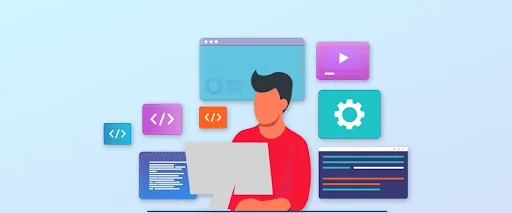
Choosing the wrong web development stack can lead to a waste of time and money. That’s why it’s important to know the web dev tech stacks and understand which one will fit your business.
To make the decision simple for you, we’ll explore the best web development stacks you can use. We’ll understand the technology behind each tech stack, which will help you get a better idea of what aligns with your developers. We’ll categorize which stack fits each type of web development project, so you can make a choice quickly.
Plus, we’ll learn the pros and cons of each stack that will help you to make the right decision. So, let’s get started!
A Quick Comparison of Popular Web Stacks
| Stack | Frontend | Backend | Database | Ideal For | Scalability |
|---|---|---|---|---|---|
| MERN | React | Node.js + Express | MongoDB | Dynamic SPAs, modern web apps | High |
| MEAN | Angular | Node.js + Express | MongoDB | Structured enterprise-level applications | High |
| JAMstack | Static JS (React, etc.) | API services (Serverless) | Headless CMS / NoSQL | Fast, SEO-friendly, static content sites | Very High |
| LAMP | HTML/CSS/JS | PHP + Apache | MySQL | Blogs, CMS sites (WordPress, Joomla) | Moderate |
| Ruby on Rails | HTML/CSS/JS | Ruby on Rails | PostgreSQL / MySQL | MVPs, startups, and quick development cycles | Moderate |
| Python Stack | React / Vue | Django / Flask | PostgreSQL / MySQL | Secure apps, data-driven platforms | High |
| Serverless Stack | JS Frameworks | AWS Lambda / Firebase | Cloud DBs / Firestore | Scalable apps, fast prototyping | Very High |
What is a Web Development Stack?
A web development stack is the combination of technologies used to build a website or web application. Think of it like a toolkit; each tool has a specific role, and together they can create a complete, functional website. Here is what every web dev tech stack includes:
- Frontend (Client-Side): This is what users see and interact with. It is built with HTML, CSS, and JavaScript frameworks like React or Angular.
- Backend (Server-Side): The background logic, databases, and server operations are done by languages like JavaScript (Node.js), Python, or PHP.
- Database: This is where data is stored. The options for the database include MongoDB (NoSQL) or PostgreSQL (SQL).
The development stack matters because it impacts speed, scalability, and maintenance of the project. For example, a content-heavy site might use WordPress (LAMP stack), while a real-time app could rely on the MERN stack.
Top Web Development Stacks (With Pros & Cons)
The web development technologies can be combined in various ways to build a project. Some of the best web development stacks are listed here.
1. MERN Stack (MongoDB, Express.js, React, Node.js)
The MERN stack brings together four powerful JavaScript technologies to build full-stack web applications. It includes MongoDB for the database, Express.js for backend logic, React for the frontend interface, and Node.js to run JavaScript on the server side. Since all four use JavaScript, developers can work more easily without switching languages between the frontend and backend.
React helps create interactive user interfaces, while Node.js and Express manage the server-side operations efficiently. MongoDB stores data in a flexible, JSON-like format, which makes it easier to handle data that changes often. This combination is fast, scalable, and widely used for building modern, real-time web apps.
Pros of Using MERN Stack:
- Uses one language (JavaScript) for both frontend and backend
- React offers reusable components for faster UI development
- Node.js handles real-time updates and high-traffic applications well
- MongoDB is flexible and works well with dynamic data
- A strong community and a rich ecosystem of tools
Cons of Using MERN Stack:
- React needs extra effort for SEO, especially in content-heavy apps
- MongoDB may not be ideal for apps needing complex relationships between data
- Without a clear structure, large projects can become harder to maintain
Best for: Single-page apps, real-time platforms that are scalable with a single tech stack.
2. MEAN Stack (MongoDB, Express.js, Angular, Node.js)
The MEAN stack combines four powerful JavaScript-based tools: MongoDB, Express.js, Angular, and Node.js. It’s designed to help developers build full-stack applications using just one programming language across both the frontend and backend. Angular takes care of the UI, while Node.js and Express manage the server-side logic.
MongoDB handles the data layer, storing information in a flexible format that’s easy to scale. Angular brings a structured framework to the frontend, which helps manage larger projects with lots of moving parts. Overall, MEAN is great for building dynamic web applications that need a clear, maintainable structure.
Pros of Using MEAN Stack:
- JavaScript is used throughout, making development more consistent
- Angular comes with built-in tools for routing, forms, and testing
- Node.js handles concurrent requests efficiently
- MongoDB is flexible and scales well with growing data
- Suitable for teams that want a structured frontend framework
Cons of Using MEAN Stack:
- Angular’s complexity can slow down beginners
- Less flexibility compared to React-based stacks
- Real-time performance may require extra tuning
Best for: Large-scale web apps, enterprise-level platforms, and projects where structure and long-term maintainability matter.
3. JAMstack (JavaScript, APIs, Markup)
JAMstack is a modern approach to building websites that focuses on speed, security, and scalability. It stands for JavaScript, APIs, and Markup. Instead of relying on a traditional server-based backend, it serves pre-built static pages that connect to dynamic data through APIs. This makes the site load faster and reduces server costs.
JAMstack is a powerful choice for high-performance static websites. But depending on your goals, understanding the difference between static and dynamic websites is crucial before picking the right stack. Although it’s a great stack if performance and simplicity are your top priorities.
Pros of Using JAMstack:
- Extremely fast page load times thanks to static site generation
- Lower server costs and fewer backend vulnerabilities
- Easy to scale with CDN-based delivery
- Works well with headless CMS and modern tools
- Great for SEO, especially for content-heavy websites
Cons of Using JAMstack:
- Handling dynamic functionality can be more complex
- Requires more setup when dealing with user authentication
- May not suit large, interactive applications with heavy backend needs
Best for: Marketing websites, blogs, landing pages, and static sites that need high performance and strong SEO.
4. LAMP Stack (Linux, Apache, MySQL, PHP)
The LAMP stack is one of the oldest and most reliable web development stacks. It includes Linux as the operating system, Apache as the web server, MySQL for the database, and PHP for backend scripting. This combination has powered countless websites over the last two decades.
LAMP is known for its stability, open-source nature, and wide adoption. It’s easy to find hosting that supports it, and there’s a massive pool of developers familiar with the stack. If you’re building something simple to moderately complex, LAMP is still a dependable choice.
Pros of Using LAMP Stack:
- Proven and well-supported by hosting providers
- Open-source with a large community and documentation
- PHP is easy to learn and works well with MySQL
- Great compatibility with popular CMS platforms like WordPress
- Flexible enough for both static and dynamic websites
Cons of Using LAMP Stack:
- Not ideal for highly interactive, real-time applications
- Can feel outdated compared to modern JavaScript stacks
- Performance may need optimization for large-scale traffic
Best for: Content-driven websites, blogs, small business sites, and legacy systems that need reliability over cutting-edge features.
5. Ruby on Rails Stack
Ruby on Rails (often just called Rails) is a web development framework built on the Ruby programming language. It’s designed to make coding web applications faster and more enjoyable, with a focus on convention over configuration. That means a lot of decisions are already made for you, so you can move quickly.
This stack includes Ruby, Rails and often a PostgreSQL or MySQL database. It’s widely used by startups and developers who want to get their ideas off the ground fast. With Rails, you can build full-featured web apps without getting lost in technical setup.
Pros of Using Ruby on Rails Stack:
- Speeds up development with built-in tools and conventions
- Clean, readable syntax that feels natural to write
- Great for rapid prototyping and MVPs
- Large library of gems (plugins) to extend functionality
- Strong and active community support
Cons of Using Ruby on Rails Stack:
- Performance may lag for very large-scale apps
- Can be opinionated and rigid for some custom workflows
- Hosting and deployment can be trickier than PHP-based stacks
Best for: Startups, MVPs, and apps that need to launch quickly without sacrificing quality.
6. Python Stack (Django, React or Vue)
The Python stack, combining Django with React or Vue, is a powerful setup for building full-stack web applications. Django takes care of the backend, handling data, user authentication, and APIs. React or Vue steps in on the frontend to create dynamic and responsive user interfaces.
This combination gives you structure, speed, and flexibility. Django keeps your backend secure and efficient, while React or Vue helps you build smooth, modern UIs. Together, they let you build apps that are fast, scalable, and user-friendly.
Pros of Using Python Stack:
- Django is secure, scalable, and follows clean coding practices
- React and Vue offer great flexibility for building modern UIs
- Good for large, complex projects that need both power and speed
- Strong developer community and lots of ready-to-use packages
- Easily supports RESTful APIs or GraphQL for frontend-backend interaction
Cons of Using Python Stack:
- Can feel heavy or overkill for small apps
- Learning curve is a bit steep if you’re new to full-stack development
- Setup and integration between the frontend and backend takes some effort
Best for: Enterprise apps, SaaS platforms, and any project that needs a strong backend with a smooth, interactive frontend.
7. Serverless Stack (AWS Lambda, Firebase, etc.)
The Serverless stack takes away the need to manage servers by letting cloud providers handle all the infrastructure. Services like AWS Lambda and Firebase let you run your code on demand, without worrying about scaling or maintenance. This means you can focus more on writing features and less on managing servers.
This approach uses functions triggered by events, which makes it cost-effective and highly scalable. Since the backend is split into small, independent pieces, development and updates become faster and more flexible. It’s a modern way to build apps that grow with your needs.
Pros of Using Serverless Stack:
- No server management or infrastructure setup required
- Automatically scales based on traffic and usage
- Pay only for the resources you consume
- Faster development cycles due to modular functions
- Built-in high availability and fault tolerance from cloud providers
Cons of Using Serverless Stack:
- Can become expensive with very high or unpredictable traffic
- Debugging and monitoring can be more complex than traditional setups
- Vendor lock-in risk if relying heavily on one cloud provider
Best for: Event-driven applications, APIs, microservices, and startups that want to move fast without investing in server infrastructure.
When selecting a stack, it’s essential to align it with your development process. The right choice will allow you to use agile methodology in web development to ensure flexibility and rapid delivery. If you are still not clear about the choice, let’s decode it in the next section based on the type of project.
How to Choose the Right Web Development Stack by Project Type?
Choosing a tech stack feels like standing in a hardware store staring at tools; they all look useful, but you only need a few. Here’s how real developers decide, based on what actually gets built.
For Simple Websites (Brochure Sites, Portfolios)
If you’re making a basic site that mostly shows information:
- Static Generators (JAMstack) like Gatsby or 11ty are lightning fast
- WordPress still works if you need client-friendly editing
- Avoid overkill, you don’t need React for a 5-page site
I built my photography site with Eleventy and Netlify CMS. Updates take seconds, and it loads instantly.
For Web Apps (SaaS, Dashboards)
When users need to log in and save data:
- MERN/MEAN works if your team knows JavaScript
- Ruby on Rails is perfect when you need to move fast
- Django shines for data-heavy apps
We used Rails for a membership site – had the core features working in a weekend. The admin panel built itself.
For Enterprise Systems
Big companies need different things:
- Java/Spring for ultra-stable banking apps
- .NET when Microsoft integration matters
- MEAN works well for internal tools
A hospital client needed HIPAA compliance – we went with .NET for the security features.
For Real-Time Apps (Chat, Games)
When milliseconds matter:
- Node.js + Socket.io is the classic choice
- Firebase handles the hard parts for you
- Elixir/Phoenix for massive scale
Built a live auction site with Firebase – their real-time database saved months of work.
For MVPs and Startups
When you need to test fast:
- Rails or Laravel for quick results
- Serverless to avoid infrastructure
- No-code tools for super simple ideas
My last startup prototype used Bubble first, then we rebuilt it in Rails after validation.
The best stack is the one that gets your project completed with all the functionalities required. If you can’t figure it out, learn what a web development company does. It will help you understand how they choose a stack and build sites that align with their client’s requirements.
FAQs About Web Development Stacks
Which web development stack is best for beginners?
The MERN stack (MongoDB, Express.js, React, Node.js) is a solid choice for beginners. It uses JavaScript throughout, which makes learning easier. You get to build both the frontend and backend using one language. Plus, there’s a huge community and plenty of resources.
How do I choose the right web stack for my project?
Start with your project goals, team skillset, and budget. A simple blog needs a different setup than a real-time chat app. If speed to market matters, go for a stack that’s easy to prototype. Scalability, security, and support should also guide your decision.
Is MERN better than MEAN?
It depends. MERN (React) is more flexible for dynamic UIs, while MEAN (Angular) works better for structured, large-scale apps. If you prefer TypeScript and a strict organization, MEAN might suit you. For quick prototyping, MERN wins.
Can I mix and match technologies from different stacks?
Yes, you absolutely can. Most modern apps aren’t locked into one predefined stack. Developers often combine tools that work well together. Just make sure they integrate smoothly and don’t overcomplicate your build.
What’s the difference between LAMP and JAMstack?
LAMP is a traditional backend-heavy stack (Linux, Apache, MySQL, PHP). JAMstack is more modern and frontend-focused (JavaScript, APIs, Markup). JAMstack apps are faster and easier to scale, while LAMP is great for content-heavy sites like WordPress.
Let’s Summarize
The best web development stack depends on what you are trying to build and achieve. If you want speed and want to build a marketing site, JAMstack can be a good option. On the other hand, if you need to build a dynamic site, MERN and MEAN stacks are preferable choices.
You can learn the pros and cons of each web development technology and then, based on that, choose a tech stack. The right combination of tools can vary based on the feature requirements and scale of the project.
In the end, the best stack is the one that lets you build the site you thought of and is easy to maintain. If you need help building a site with the right technologies and skilled developers, connect with us today!




